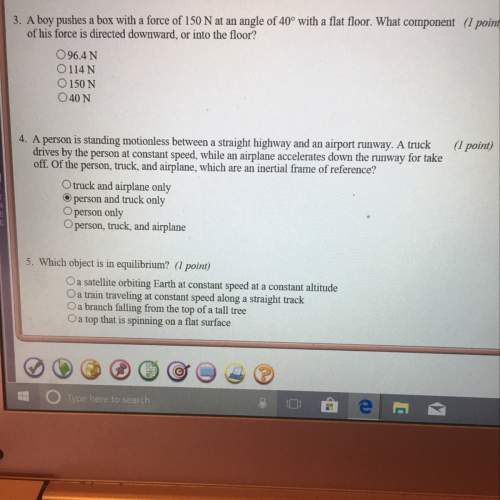
Physics, 06.10.2019 06:00 Sophiiiiamm374
Apositron (the electron’s antiparticle) has mass 9.11×10−31 kg and charge q0=+e=+1.60×10−19 c. suppose a positron moves in the vicinity of an α (alpha) particle, which has charge q=+2e=3.20×10−19 c and mass 6.64×10−27 kg. the α particle’s mass is more than 7000 times that of the positron, so we assume that the α particle remains at rest. when the positron is 1.00×10−10 m from the α particle, it is moving directly away from the α particle at 3.00×106 m/s. (a) what is the positron’s speed when the particles are 2.00×10−10 m apart?

Answers: 1
Another question on Physics

Physics, 22.06.2019 08:40
When temperature of a substance increases, of its particles increase resulting in more between particles. real world applications of thermal expansion absolute zero (-273 degrees c) is the lowest possible temperature on the kelvin scale. it is a measure of where a substance has no kinetic energy. heat is a process of the . energy flows spontaneously from a object to a until equilibrium is reached. heat is measured in heat is transferred throughis a method of heat transfer that occurs between particles of matter that are in direct contact with each other. are poor conductors that impede / reduce the rate of heat transfer. is a method of heat transfer that occurs in fluids (non-solids) by means of currents. real world application of convectiona method of heat transfer through electromagnetic waves. when energy moves from one object to another inside a closed system, no energy is or in the system in the transaction. systems will spontaneously move to a state of organized energy or high disorder over time called
Answers: 2

Physics, 22.06.2019 15:30
To understand the behavior of the electric field at the surface of a conductor, and its relationship to surface charge on the conductor. a conductor is placed in an external electrostatic field. the external field is uniform before the conductor is placed within it. the conductor is completely isolated from any source of current or charge. part a: which of the following describes the electric field inside this conductor? it is in the same direction as the original external field.it is in the opposite direction from that of the original external field.it has a direction determined entirely by the charge on its surface.it is always zero. part b: the charge density inside the conductor is: 0non-zero; but uniformnon-zero; non-uniforminfinite part c: assume that at some point just outside the surface of the conductor, the electric field has magnitude e and is directed toward the surface of the conductor. what is the charge density η on the surface of the conductor at that point? express your answer in terms of e and ϵ0
Answers: 1


Physics, 23.06.2019 02:50
Adielectric-filled parallel-plate capacitor has plate area a = 30.0 cm2 , plate separation d = 9.00 mm and dielectric constant k = 3.00. the capacitor is connected to a battery that creates a constant voltage v = 15.0 v . throughout the problem, use ϵ0 = 8.85x10-12 c2/n.m2 . find the energy u1 of the dielectric-filled capacitor.
Answers: 2
You know the right answer?
Apositron (the electron’s antiparticle) has mass 9.11×10−31 kg and charge q0=+e=+1.60×10−19 c. suppo...
Questions


Mathematics, 21.07.2019 17:30

Mathematics, 21.07.2019 17:30


History, 21.07.2019 17:30

Computers and Technology, 21.07.2019 17:30

History, 21.07.2019 17:30


Mathematics, 21.07.2019 17:30

Physics, 21.07.2019 17:30






Advanced Placement (AP), 21.07.2019 17:30

History, 21.07.2019 17:30

Mathematics, 21.07.2019 17:30

Mathematics, 21.07.2019 17:30

Mathematics, 21.07.2019 17:30




